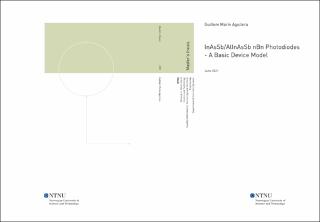| dc.contributor.advisor | Brudevoll, Trond | |
| dc.contributor.advisor | Fimland, Bjørn-Ove | |
| dc.contributor.advisor | Selvig, Espen | |
| dc.contributor.author | Marín Aguilera, Guillem | |
| dc.date.accessioned | 2021-11-03T18:19:49Z | |
| dc.date.available | 2021-11-03T18:19:49Z | |
| dc.date.issued | 2021 | |
| dc.identifier | no.ntnu:inspera:77038608:46969859 | |
| dc.identifier.uri | https://hdl.handle.net/11250/2827703 | |
| dc.description.abstract | I dette arbeidet er bandstrukturen til en Unipolar Barrier Infrared Detector simulert. Designforslaget for sensoren er basert på en tidligere studie utført av forfatteren. Komponenten består av en heterostruktur som inneholder InAsSb, et fremtredende halvledermateriale i infrarød sensing, og gittertilpasset AlInAsSb. Førstnevnte utgjør kontakten og det aktive absorpsjonslaget, mens det siste har blitt brukt som barrierelag.
Poisson-kontinuitets-løseren som presenteres i dette arbeidet, har som mål å være et nyttig verktøy i utformingen av infrarøde fotodetektorer. Skriptet løser Poisson-ligningen og kontinuitetsligningen for hull ved hjelp av Newton-Raphson tilnærmingen med en Finite Differences metode. Modelleringen av materialparametrene er hentet fra litteraturen og tilpasset komponentens kontekst. Derfra bruker løseren de innebygde verdiene til disse parametrene for å finne en første omtrentlig løsning på det elektrostatiske potensialet til heteroovergangen (V). Ved å bruke en iterativ prosess blir den første gjetningen finpusset til konvergens er oppfylt. Det elektrostatiske potensialet etter hver iterasjon brukes til å beregne gradienten til kvasi-Fermi-nivået for hull (Efh) utenfor termisk likevekt. Når Poisson- og hullkontinuitets-likningene er løst, bidrar V og Efh til å bygge båndstrukturen til heterostrukturen. Med denne informasjonen beregnes andre relevante størrelser som ladningsbærerfordelingen ved båndkantene over komponenten, elektrisk felt-profil og mørkestrømtettheten (Jdark).
Relevante tall i detektorens ytelse er gjennomgått, og analysene av simuleringsresultatene stemmer overens med det som er rapportert i litteraturen, som viser at løseren gjennomfører sitt oppdrag på en vellykket måte. Designet presentert i dette arbeidet gir Jdark = 8.2x10-5 A / cm2 i metning ved 200 K. Mørkestrømtettheten rapportert her kan konkurrere med resultater presentert i andre rapporter der lignende arkitektur- og materialsystemtilnærminger er benyttet. | |
| dc.description.abstract | In this work, the band structure of a Unipolar Barrier Infrared Detector has been simulated. The sensor's design proposal is based on a previous study carried out by the author. The device consists of a heterostructure containing InAsSb, a prominent semiconductor material in infrared sensing, and lattice-matched AlInAsSb. The former constitutes the contact and the active absorption layer, while the latter has been used as the barrier layer.
The Poisson-continuity solver presented in this work aims to be a helpful tool in the design of infrared photodetectors. The script solves the Poisson Equation and the continuity equation for holes using the Newton-Raphson method with a Finite Differences scheme. The modelling of the material parameters has been taken from literature and adapted to the context of the device. From there, the solver uses the built-in values of those parameters to approximate an initial solution to the electrostatic potential of the heterojunction (V). Using an iterative process, the initial guess is refined until convergence is met. The electrostatic potential after each iteration is used to calculate the gradient of the hole quasi-Fermi level (Efh) outside thermal equilibrium. Once the Poisson and the hole continuity equations are solved, V and Efh help to build the band structure of the heterostructure. With this information, other relevant quantities such as the distribution of carriers at the band edges across the device, the electric field profile, and the dark current density (Jdark) are calculated.
Relevant figures in the detector's performance have been reviewed and the analysis of the simulations results are in good agreement with that reported in the literature, showing the solver successfully accomplishes its mission. With the design presented in this work, Jdark = 8.2x10-5 A/cm2 in saturation at 200 K. The dark current density reported here can compete with results presented in other reports using a similar architecture and material system approaches. | |
| dc.language | eng | |
| dc.publisher | NTNU | |
| dc.title | InAsSb/AlInAsSb nBn Photodiodes - A Basic Device Model | |
| dc.type | Master thesis | |
